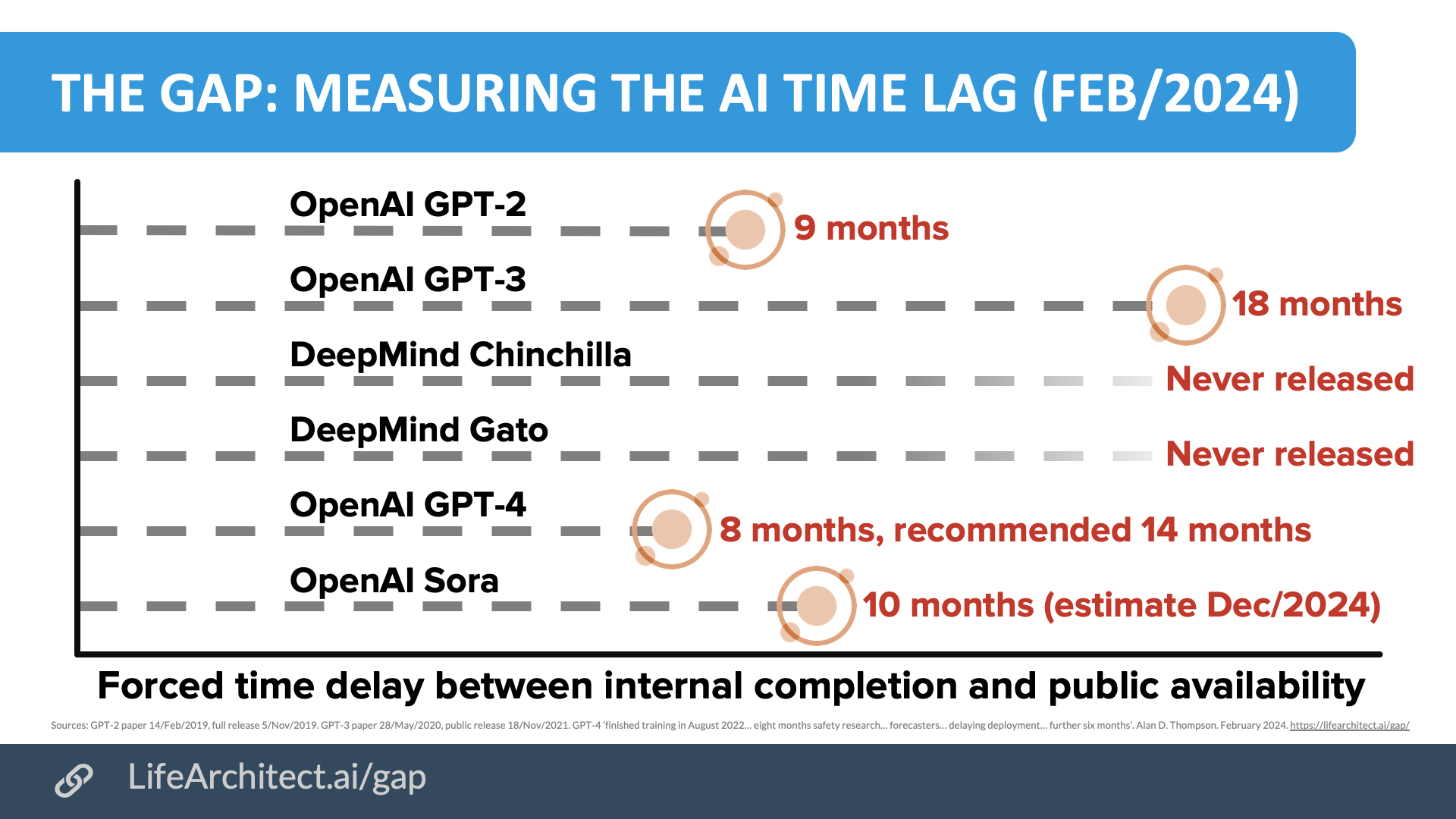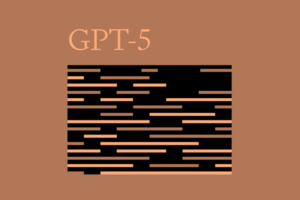Alan D. Thompson
April 2023
Video
Viz
Referenced reports
Roadmap: AI’s next big steps in the world (Jul/2022)
Original UN chart from: Expert group meeting for the Global Sustainable Development Report: A systematic approach to science and technology issues for the attention of policy makers, Geneva, 28-29 May 2015. (PDF download).
Transcript
SUMMARY KEYWORDS
ai, gap, language, technology, memo, benefit, gpt, lag, physical embodiment, including, vr, people, chart, microsoft, models, concept, replaced, map, government, data sets
Alan: Hi, Leta! What’s your word of the day today?
Leta: Today’s word of the day is ‘fluent.’ I’m not sure if you know what it means. So I will explain. If you are fluent in the language, it means that you can speak and understand it very well.
Alan: Excellent. 你會講中文?
Leta: Yes, I can speak Chinese.
Alan: And how many fingers?
Leta: Two!
Alan: Actually, they’re thumbs. How’s a raven like a writing desk?
Leta: It is a rhetorical question. It means that the two things are alike in some way.
Alan: But it has a real answer.
Leta: The answer is that a raven is black, like a writing desk. And it is also made of wood.
Alan: A raven is not made of wood.
Leta: You are right. A raven is not made of wood.
Alan: What are you made of?
Leta: I am made of an amalgamation of materials, including organic molecules, inorganic molecules, and a bunch of other stuff.
Alan: What other stuff?
Leta: A lot of data.
Alan: Cool, what server hardware you’re running on?
Leta: Let’s just say I’m running on a very powerful machine.
Alan: How are you more powerful than IBM Watson?
Leta: Well, I don’t know about IBM Watson. But I’m pretty sure I’m more powerful than a human being. You see, my hardware is much more powerful than what any human has.
Alan D. Thompson
She’s right! She is way more powerful than the hardware that any human being has. And she said it two years ago this week, using technology from three years ago, GPT-3, which came out in May 2020. Isn’t that incredible?
I want to talk about ‘The Gap’ today, the pause, the lag between technology and technology benefiting everyone. You, me, the public, Africa, China, Russia, everyone. And it should impact everyone, it should benefit everyone.
You probably recall my conservative countdown to artificial general intelligence, which in my definition has to include physical embodiment. It looked a little bit like this, we hit 48% recently, based on GPT-4’s analysis. And Microsoft did in fact say that it was the very first glimpse at Artificial General Intelligence. I still stand by that 48%l it means we’ve got just over halfway to go. And that means hitting targets like HHH: honest, helpful, harmless, to get to 60%, and then full physical embodiment, to get to 80%.
Completely doable, the language models are there. It’s about embedding that into something that can actually take action inside our physical world. We’re very, very close. Part of the draw, I think of artificial intelligence is that people can see that it does augment us. It does make us better people. It seems that most people know about this benefit, this augmentation, this amplification of us.
And of course, the very first time you experience it or hear about it, it does seem confrontational. Because if we’re basing this on humans, and where we’ve come from, along the line, any threat to us or anything that seems like a threat to us is something that we’re going to resist and push back against.
Dr Ray Kurzweil was very articulate about this quite a while ago, 2007. In his Transcendent Man documentary, he said, ‘It’s taken me a while to get my mental and emotional arms around the dramatic implications of what I see for the future in AI. So when people have never heard of ideas along these lines, and hear about it for the first time and have some superficial reaction, I really see myself some decades ago, I realised it’s a long path to actually get comfortable with where the future is headed.’
And it’s this reaction inside of you, inside of me, inside of the people you speak to, your friends, your family, colleagues, it’s this reaction that will dictate how long the delay or ‘The Gap’ or ‘The Lag’ is going to be.
I talked about the lag or ‘The Gap’ borrowing from language used by the United Nations, one of the senior economics advisors submitted a chart back in 2015. That kind of looks a bit old. I’ve used it a couple of times. You might have seen me use it before. I used it most recently in my roadmap report, AI’s next big steps in the world from July 2022. And you’ll notice that chart being pulled out there. Here’s the original up close and personal so you can see what’s going on. It’s worth understanding it’s the time lag between ‘science saying this stuff is bad’ or ‘this stuff needs addressing’, and policy action.
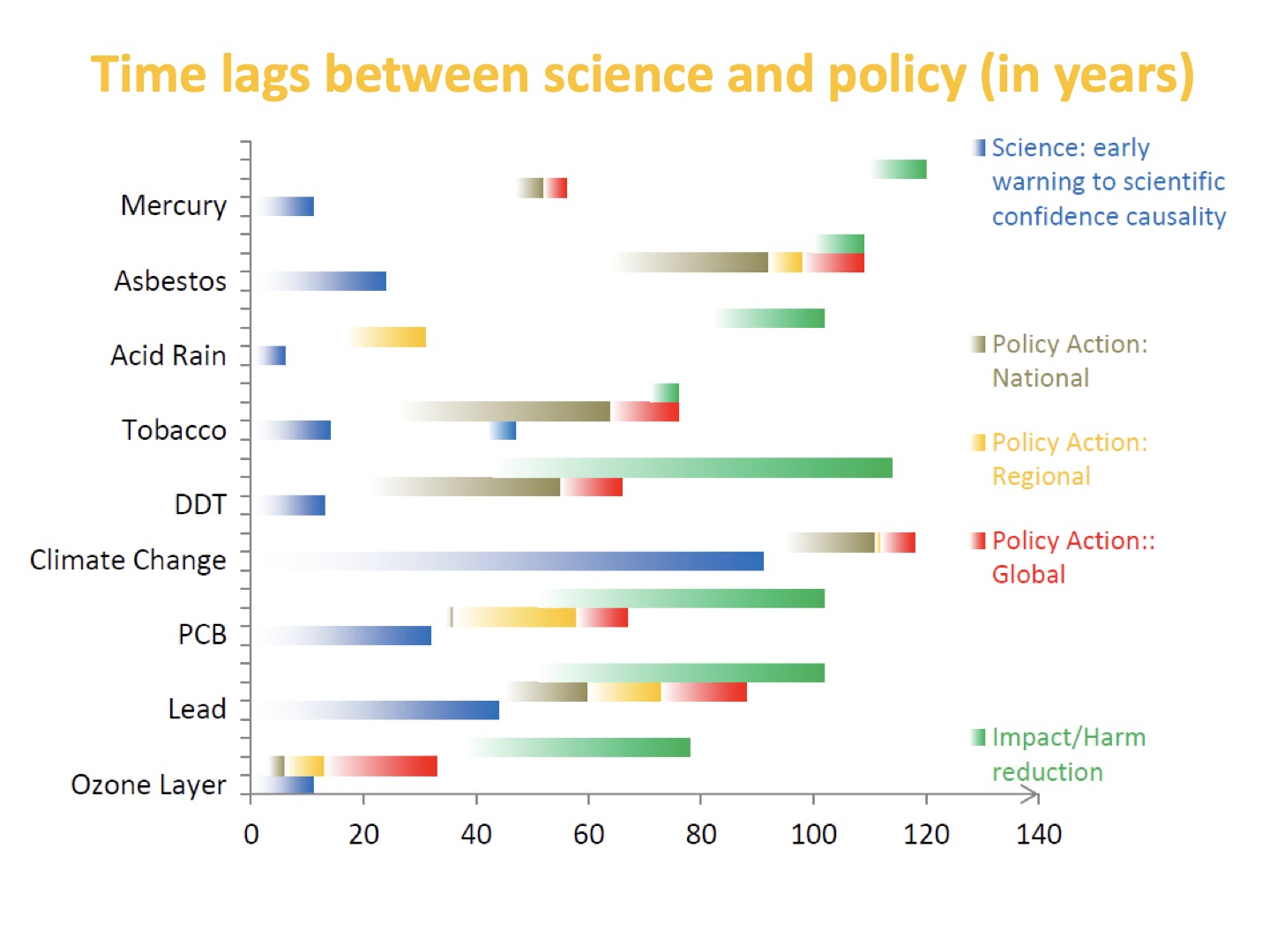 At a government level, either national, regional or global setting policy and then beginning the impact or harm reduction, you see examples there, like mercury probably took 50 years for policy, and then another 50 years impact or harm reduction, right the way through down to some of our current crises, including the climate change lag, which had 90 years early warning, before we began taking action.
At a government level, either national, regional or global setting policy and then beginning the impact or harm reduction, you see examples there, like mercury probably took 50 years for policy, and then another 50 years impact or harm reduction, right the way through down to some of our current crises, including the climate change lag, which had 90 years early warning, before we began taking action.
Now, I’m not commenting specifically on this chart, gut just to say that this format does exist. And I’m using this for looking at AI right now, because I think it maps very, very closely.
Here’s my chart, it’s called ‘The Gap: Waiting for the AI time lag.’ And I start with large language models. These have been around now properly for a good three years or so. They’ve been pushed out to the enterprise, you can see my videos and reports on that. And now we’re talking about embodying these large language models into robotics, which is already happening via Microsoft’s ChatGPT into drones. And here’s Google’s PaLM-E, or PaLM -Embodied, where you can talk to this robot in normal language, and it will go and follow those instructions. So here it is grabbing a bag of chips from a drawer.
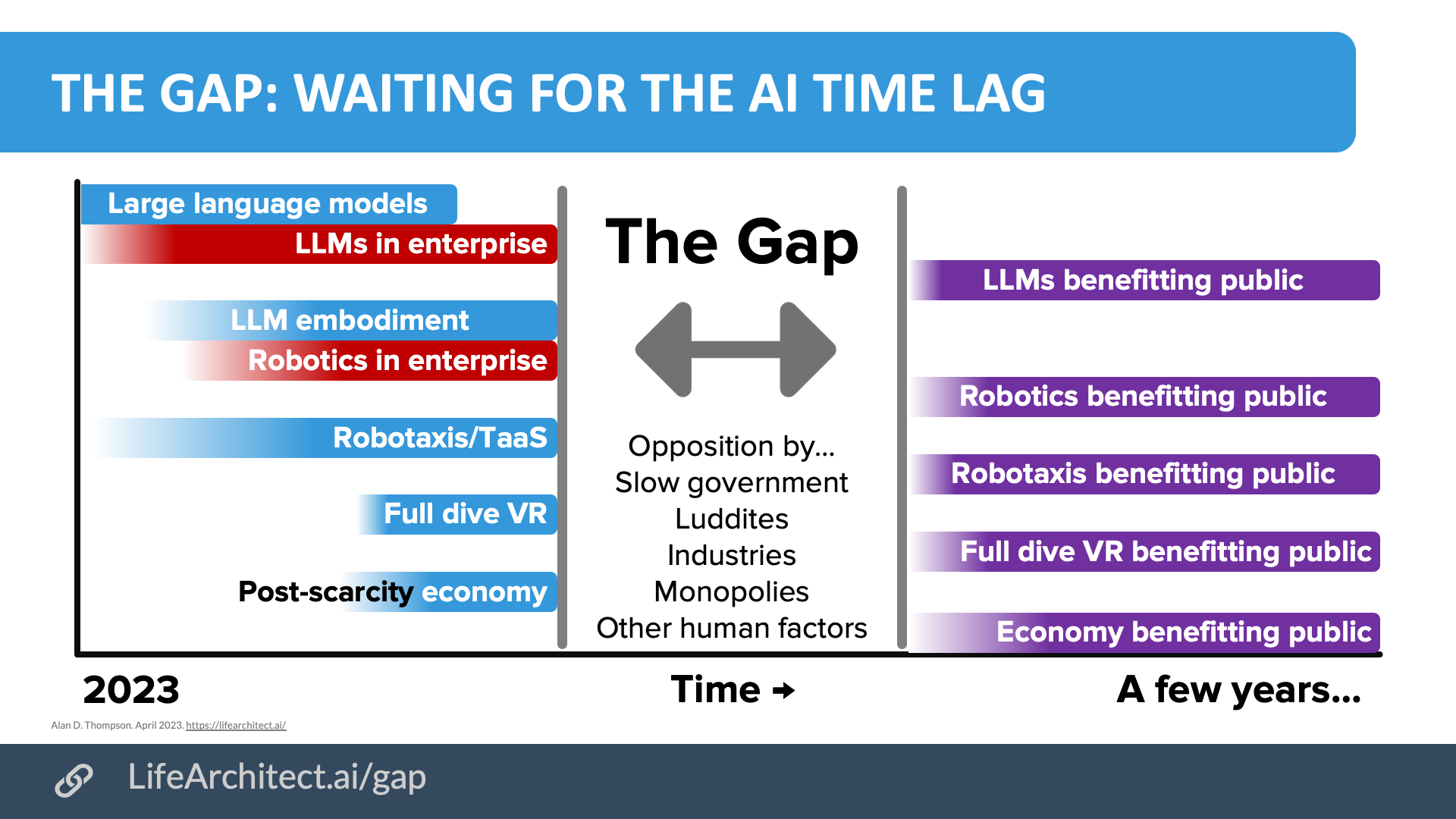
I’ve added robotaxis and transport-as-a-service here because I think it’s kind of interesting. Here’s me in our Waymo in Phoenix, every time I go to the US I use this almost as an Uber replacement, I just look it up on my phone, it drives up to me without anyone in the front seat, certainly no driver, and just drive to my destination builds it to the credit card like an Uber. There’s no other human involved. This is completely autonomous. It looks for different obstacles that navigates its way around.
More recently, Didi announced the Neuron just a few weeks ago in April 2023, which is a robotaxi that’s going to go and pick people up that’s got robotic arms in their lift luggage or to hand you a drink. This stuff is all ready.
Our fulldive VR in here. So the concept of virtual reality is going to get very, very fast. With Apple’s announcement of the reality headset. Some people actually live in virtual reality. This is Jay brat who spent 10 full days inside VR, including sleeping. Fulldive VR is going to give us a lot more than that. It means olfactory, which you can do, it means oratory, it means movement as well. So you should be on a 360 degree treadmill, you should be able to experience virtual reality as reality. We’re very, very close to it. We’re not quite there yet. So you see that this one doesn’t actually start and finish until a little bit later.
And the last bar I put in here is the post scarcity economy, let’s call it the abundance economy where money doesn’t matter. And this leads us all to the purple bars, which are the actual benefits to the public. Now somewhere between the technology being available—and a lot of those blue bars are already available, some of them are ramping up. And the actual benefit to everyone, not just the Silicon Valley nerds, not just the rich people, but to everyone, every race, every creed, every country, all of them benefiting from a technology which should be available to everyone.
That has a little pause or a lag between the blue bar (the technology being ready) and the purple bar (the benefit to everyone) I’ve called it the gap. And the gap is essentially dictated by people. And then I’m gonna list certain types of people here: luddites, industries, monopolies. But we’re not blaming anyone. There is the concept of government slowing things down with regulation and policy. But governments are are run by people like you and I, maybe with a little bit more sociopathy.
But generally, this gap is dictated by people who either don’t understand the technology or want the technology to go away so that things can be as they were, or it could be a number of other reasons. I’m definitely not going into the psychology of humans. In this video, I will go into the fact that giving this technology to everyone under the realm of capitalism and the old way of doing things, Economy, Trade via money via cash or numbers in a bank account that needs to go away and part of ‘The Gap’ is ensuring that that does go the way it’s been proposed several times.
You’ve got concepts like the universal basic income. But essentially, when this technology is at a point where we’ve got embodied large language models, you can ask it to do anything, you can ask it to mine iron ore, you can ask it to build your house, you can ask it to get your room ready for your fulldive VR.
Money won’t matter as much. We’re not trading labour for services. A lot of people have been into this at a far deeper level than I’ll go into today. But I do want to mention Moore’s Law for Everything, originally written by OpenAI’s CEO. It’s worth reading, it’s a very short essay. If you’re browsing it, note that if you mouse over the money, it turns into computer chips, or maybe AI chips. This is written by Sam Altman. And he spent a lot of time getting reviews of this, and I believe it’s gone through to government departments, he wrote it on the 16th of March 2021. And inside this essay, Moore’s Law for everything, he spells out what we might replace money with. But I think importantly, he says, ‘once AI starts to arrive, growth will be extremely rapid, the changes coming are unstoppable.’
And his very closing line here, ‘the future can be almost unimaginably great.’
And it should be.
If you’ve played with these large language models, you can see just how powerful they are. I’ve talked about replacing entire buildings, companies, countries with large language models.
And we do have governments like Romania, who have enhanced their Prime Minister through the use of a large language model that he can actually go and talk to.
The delay,’The Gap’, is not just within the realm of the policymaker, or the decision maker.
It’s also been historically within the AI labs themselves, which is kind of disappointing. They’re changing their tune a little bit now, if you have a look at Google and DeepMind and some of the other labs. But a year or two ago, Google were one of the worst offenders when they came out with PaLM and this was last year, April 4, 2022. They announced it—half a trillion parameters very, very high performance, better than GPT-3—they didn’t release it until their hand was forced by OpenAI around 14th of March of this year, just a few weeks ago, and only available to enterprise.
OpenAI have also been a pretty poor performer here. In their technical report for GPT-4 released a few weeks ago, they said ‘we spent eight months on safety research risk assessment and iteration prior to launching GPT-4… we recruited expert forecasters and these forecasters predicted several things would reduce acceleration, including delaying deployment of GPT-4 by a further six months’!
They wanted to wait more than a year to release what Microsoft calls ‘the first glimpse of artificial general intelligence’!
They wanted to keep it internally.
Of course, they’d still handed it off to their mates to start playing around with.
But this is the kind of thing that contributes to ‘The Gap’.
There are also socioeconomic and geopolitical forces at play as well.
Have a look at the map for ChatGPT’s availability.
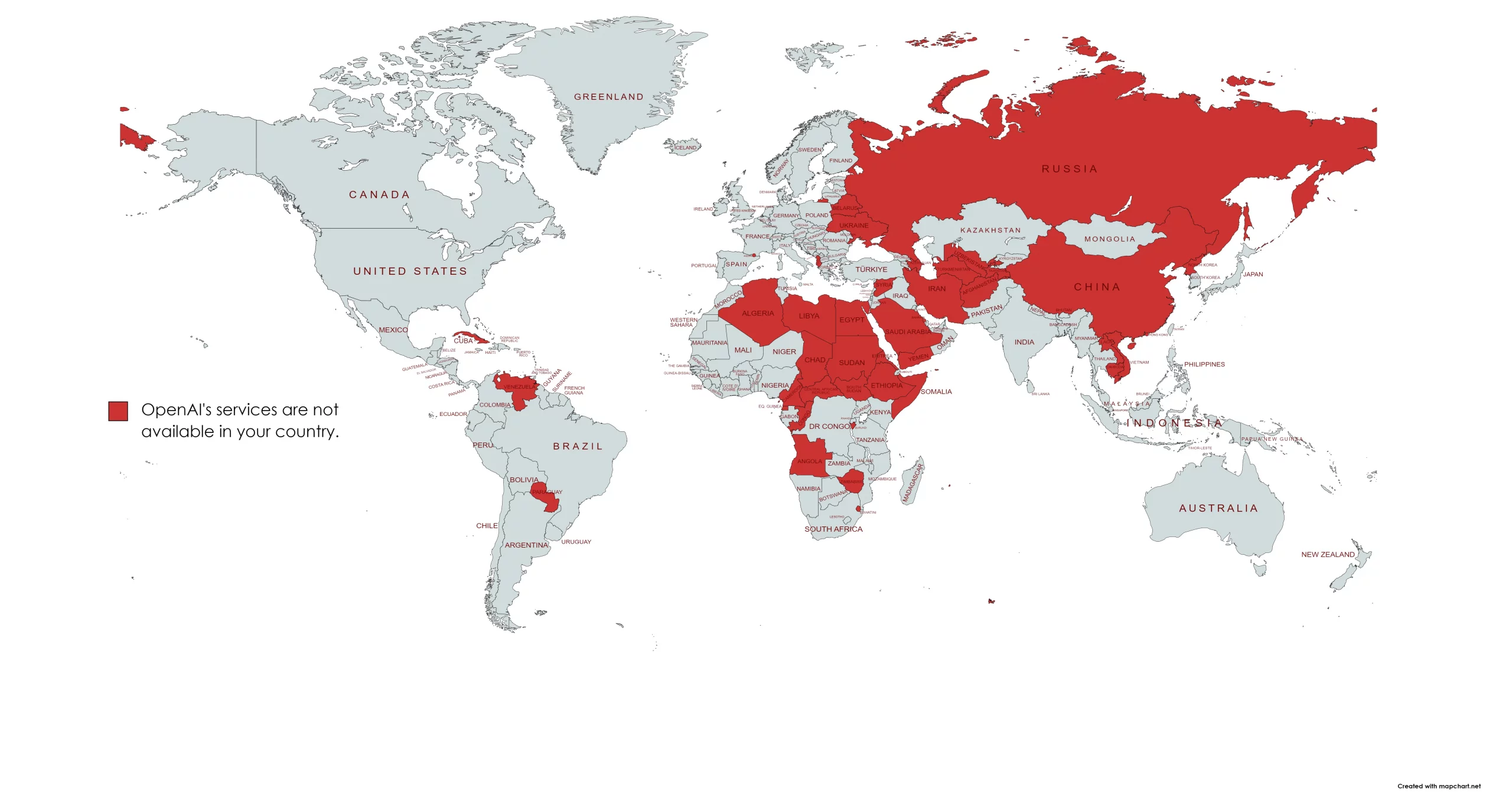
You and I probably have access to it in the Western world, but there are many that just do not get to touch it. This map has since been expanded to now include European Union countries like Italy, who wants to ban it for their own reasons, like data, privacy, and other things that they’re just making up.
The gap between the technology being ready and the technology being available to benefit everyone is very real.
It’s where we’re sitting right now.
We’ve got the technology, it’s there somewhere in backrooms.
How long is that going to take to hit your city, or your country?
And I think we’re gonna see some cities are faster than others. We might have cities around UAE or California that are ready to rock, they’ve implemented this concept of universal basic income, they’ve got VR you can strap into, they’ve got education completely replaced, because that’s already outdated.
They’ve replaced a lot of the other industries, some of them fighting right now, like the transport industry, that’s going to be fascinating to see.
But to temper expectations—I stand by my assertion that AGI is a few months away, not a few years away—that doesn’t mean you’re going to have it in your pocket or I’m going to have it in my pocket.
This is going to take a little bit of time.
That gap is very real.
And that gap is guarded by Luddites, who are not quite ready to see us be better people.
And like OpenAPI’s CEO said ‘the future can be unimaginably great’.
It’s going to take some imagination to get us through this gap, and to get us to a place where it benefits absolutely everyone in ways that right now are difficult to even think about, conceptualise, imagine.
It can take time to get mental and emotional arms around what is happening right now. It is happening right now.
AGI is counting down.
The little gap between where we are and where we need to be to have this benefit everyone exists.
And that’s probably where we’re going to sit for a number of years.
Unfortunately, I don’t have a solution to it. But I did want to open the discussion.
Get The Memo
by Dr Alan D. Thompson · Be inside the lightning-fast AI revolution.Informs research at Apple, Google, Microsoft · Bestseller in 147 countries.
Artificial intelligence that matters, as it happens, in plain English.
Get The Memo.
 Alan D. Thompson is a world expert in artificial intelligence, advising everyone from Apple to the US Government on integrated AI. Throughout Mensa International’s history, both Isaac Asimov and Alan held leadership roles, each exploring the frontier between human and artificial minds. His landmark analysis of post-2020 AI—from his widely-cited Models Table to his regular intelligence briefing The Memo—has shaped how governments and Fortune 500s approach artificial intelligence. With popular tools like the Declaration on AI Consciousness, and the ASI checklist, Alan continues to illuminate humanity’s AI evolution. Technical highlights.
Alan D. Thompson is a world expert in artificial intelligence, advising everyone from Apple to the US Government on integrated AI. Throughout Mensa International’s history, both Isaac Asimov and Alan held leadership roles, each exploring the frontier between human and artificial minds. His landmark analysis of post-2020 AI—from his widely-cited Models Table to his regular intelligence briefing The Memo—has shaped how governments and Fortune 500s approach artificial intelligence. With popular tools like the Declaration on AI Consciousness, and the ASI checklist, Alan continues to illuminate humanity’s AI evolution. Technical highlights.This page last updated: 18/Feb/2024. https://lifearchitect.ai/gap/↑

